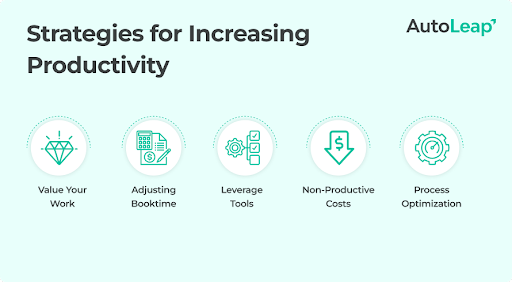Are you struggling to keep your auto repair shop running at maximum productivity? Worry not—industry expert Cecil Bullard is here to rescue you through this webinar on maximizing productivity.
Cecil Bullard, CEO of ‘The Institute for Business Excellence,’ specializes in business systems and processes. He works with business owners, managers, and service advisors to learn what they need to succeed in the auto repair industry and maintain that success.
Understanding productivity rates
Cecil reveals a concerning picture when understanding productivity rates in the auto repair industry: the standard productivity rate is around 72%. This implies significant costs: what appears as $39 per technician hour can escalate to about $54 when accounting for unproductive time. This low productivity rate has a substantial impact on profits. It’s not just about what technicians are paid per hour but how much productive work they do.
Interestingly, this issue isn’t typically the technicians’ fault. Cecil shared a case study highlighting a pay plan offering $36 to $47 per hour based on productivity, yet productivity remained at 65-70%. This suggests that the root cause of productivity challenges often lies in management practices rather than the technicians’ performance.
Strategies for increasing productivity

- Value Your Work: Owners, often former technicians, might undervalue their services because they are familiar with them. Cecil emphasizes that adjusting this mindset is crucial
- Adjusting Booktime: Booktime is adjusted for the reality of the job, including setup and cleanup times, by applying a 1.2 to 1.3 multiplier. Booktime alone doesn’t consider all aspects of a job, so adding a multiplier ensures that all work is billed, providing a more accurate reflection of the time and effort involved.
- Leveraging Your Management Tools: Enhancing productivity and profitability often hinges more on management decisions and less on the tools in the shop. The root causes of productivity issues usually require direct conversations with technicians to identify and rectify workflow obstacles.
- Covering Non-Productive Costs: Cecil talks about covering non-productive costs, such as treating non-billable hours like a grocery store handles unsold “brown bananas.” Shops need to incorporate these costs into their pricing structure. This adjustment ensures that prices accurately reflect the actual cost of service.
- Process Optimization: Cecil believes that conducting a thorough review of how repair orders and customer interactions are managed can reveal inefficiencies and areas for improvement, enhancing overall productivity.
Understanding job multipliers and efficient processes
Cecil advises using a 1.2 multiplier for more straightforward tasks and a 1.3 multiplier for more complex ones, such as those involving older vehicles with rust issues.
He stresses the significance of technicians providing precise estimates, including job requirements, parts, and accurate time estimates to enhance service advisor efficiency.
Additionally, Cecil outlines the 25% Book Time Rule, which states that if a technician’s estimate is within 25% of book time, the service advisor must sell it at that time without allowing adjustments.
Factors for implementing different labor rates
Question from the Audience: “What are key factors to consider when implementing different labor rates?”
Some of the key factors Cecil listed were,
- Start with Profitability Goals: Determine what labor rates will ensure profitability for each job.
- Avoid Overcharging: Charge rates that reflect the job’s complexity and the technician’s expertise while remaining fair to customers.
- Set Realistic Technician Goals: Establish productivity goals based on what skilled technicians can accomplish when properly supported and equipped.
- Identify and Address Institute and Bob Problems:
- Institute Problems: Address systemic issues like dispatch processes and interruptions during jobs.
- Bob Problems: Help individual technicians recognize and overcome productivity obstacles.
- Optimize Dispatch and Scheduling: Schedule jobs to maximize technician efficiency and minimize downtime without overburdening them.
- Align Pay Systems with Productivity: Base pay on hourly rates supplemented by performance incentives tied to productivity, knowledge, and skill level.
Cecil's strategies for skilled workforce development
Question from the Audience: “How can I find and train skilled professionals for my business?”
Cecil shared his wisdom and provided with some of the following strategies,
- Good Hiring Practices: Start with a solid interview process to attract the right candidates. Use effective ads and conduct thorough interviews.
- Mentorship: Assign mentors to new hires, regardless of experience level. Have a structured training plan for each mentee.
- Consistency: Maintain consistency in hiring, training, and business practices to reinforce professionalism.
- Culture of Productivity: Foster a culture where productivity is valued and rewarded. This includes measuring, managing, and discussing productivity regularly.
- Pay Structure: Align your pay structure with productivity goals to incentivize performance.
- Effective Management: Focus on problem-solving rather than yelling or blaming employees. Identify and fix institutional issues within the business to improve productivity.
- Take Responsibility: Address issues in estimating, dispatching, scheduling, workflow, and communication to enhance efficiency and productivity.
Cecil’s key takeaways on processes and resources for success:
- Importance of Processes: Processes are crucial for product quality, profit, and productivity consistency. Every business has processes, but making them official and managed is key to improvement.
- Setting Up for Success: Ensure employees have the resources and processes they need to succeed. This involves setting clear goals for positions and workflows.
- Creating Processes: Start by teaching employees how to write processes so the responsibility doesn’t fall on one person. Identify and document all business processes, from customer interaction to follow-ups. Understand that every process will be imperfect initially. The goal is to improve continuously.
- Utilizing Management Systems: Management systems can enhance efficiency and productivity, but they require solid processes to be effective. Your processes might need to adapt based on your management system’s capabilities.
- Prioritizing Initiatives: Start implementing a management system if you don’t already have one. Focus on marketing (website, SEO/SEM) to attract clients. Coaching and process improvement come afterward to refine operations and service delivery.
Wrapping up
What you saw above was just a glimpse of what Cecil discussed. He shared so much more that can help you maximize your productivity in the shop. For those interested in hearing more insights from Cecil, his full session is available for on-demand access. Check it out here!


 Demo
Demo


